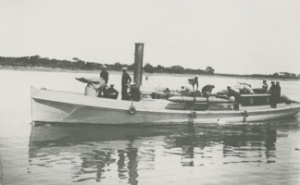Victorian navy torpedo boats operated in Port Phillip Bay as part of the defence of the defence for the port of Melbourne.
It carried 2 sets of dropping gear for 14-inch torpedoes and a 3 barrelled Nordenfeldt machine gun mounted forward. Gordon successfully completed its sea trials in April 1886 attaining a speed of 14 knots in a run from Gellibrand Point to Point Cook. It was also able to complete a full circle in 40 seconds turning in twice its own length. Gordon initially had a crew of 7 but this was increased to 11 in 1897.
Based at the Williamstown Naval Depot, Gordon and the other Victorian Navy torpedo boats Lonsdale, Nepean, Childers and Countess of Hopetoun operated in Port Phillip Bay as part of the defence for the port of Melbourne. The torpedo boats conducted regular exercises within Port Phillip Bay. During the annual Easter exercise period they routinely operated in the vicinity of Swan Island where day and night ‘attacks’ were conducted against HMVS Nelson which represented an ‘enemy’ raider. Due to its length and tonnage Gordon was restricted in its usage during bad weather.
On 10 July 1886 Gordon, while exercising with Childers, was struck by a practice torpedo holing it below the water line. To prevent the vessel from sinking it was beached to effect repairs, and it was re-floated on the next high tide.
In 1901 Gordon became part of the Commonwealth Naval Forces and continued to operate from Williamstown Naval Depot as part of the defensive forces within Port Phillip Bay. It remained active as a torpedo boat, under the command of Chief Gunner John Blair, but was also used for target towing, patrol, training and transport duties. On 10 July 1911 Gordon became part of the Royal Australian Navy, as a non-commissioned tender (support vessel) by which time it was restricted to basic training, transport and target towing duties.
On 14 November 1914 Gordon was accidently rammed and sunk by a picket boat near Williamstown Dockyard without loss of life. The vessel was salvaged but found to be beyond economical repair and subsequently scrapped.

